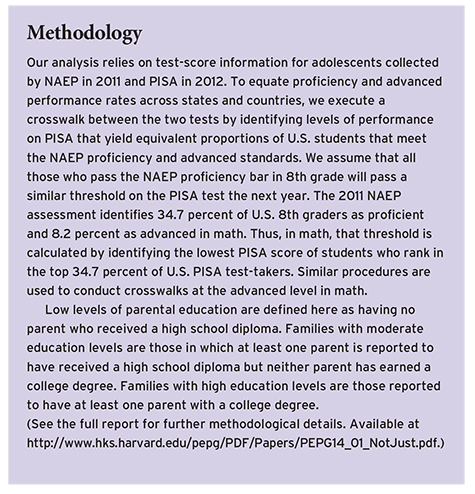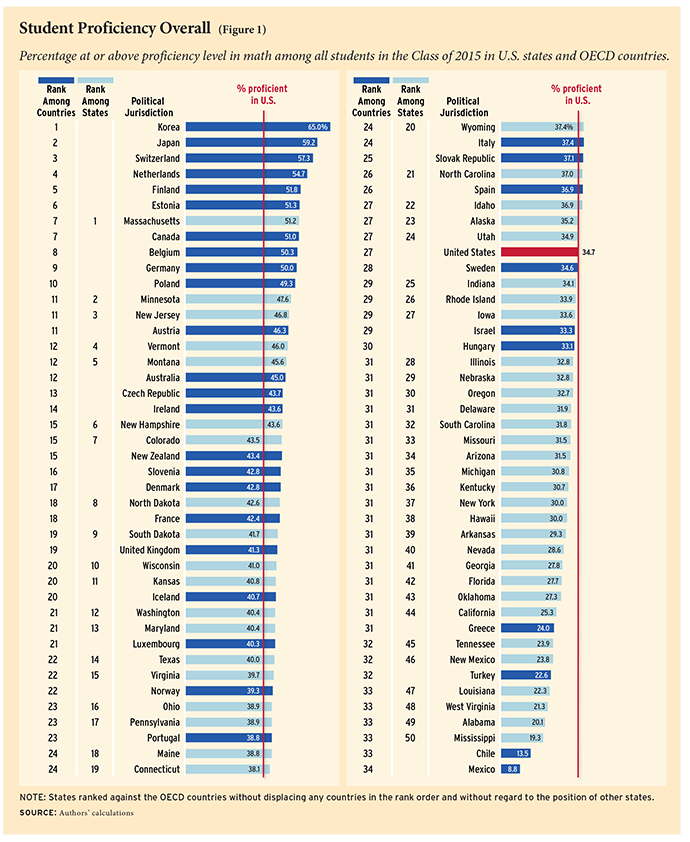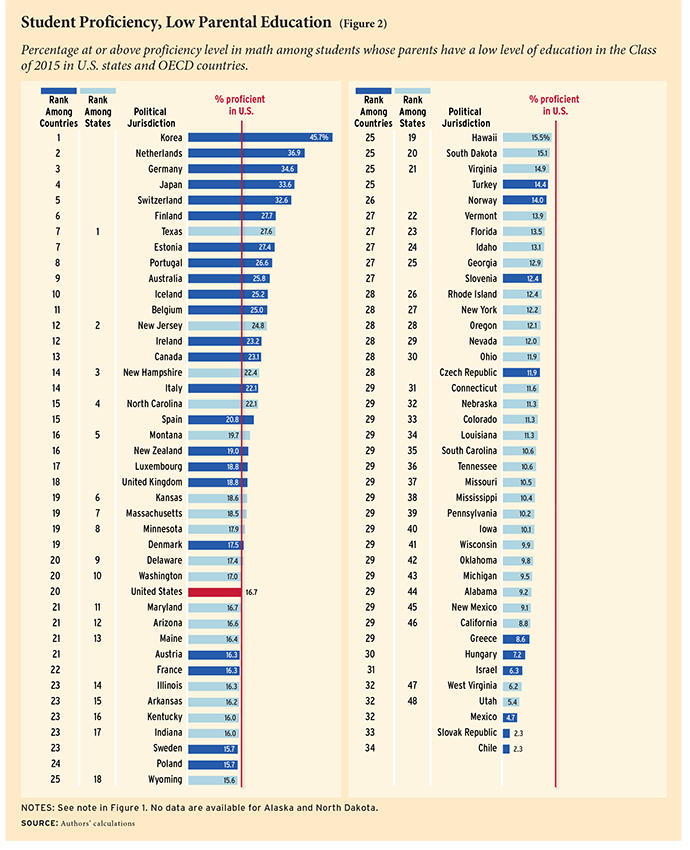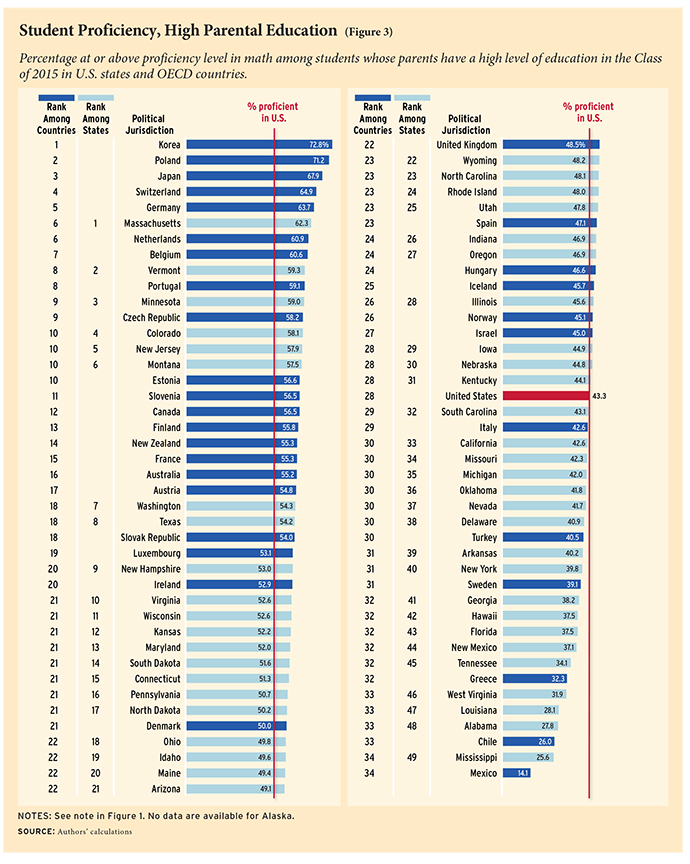“The big picture of U.S. performance on the 2012 Program for International Student Assessment (PISA) is straightforward and stark: It is a picture of educational stagnation…. Fifteen-year olds in the U.S. today are average in science and reading literacy, and below average in mathematics, compared to their counterparts in [other industrialized] countries.”
U.S. secretary of education Arne Duncan spoke these grim words on the bleak December day in late 2013 when the international tests in math, science, and literacy were released. No less disconcerting was the secretary’s warning that the nation’s educational problems are not limited to certain groups or specific places. The “educational challenge in America is not just about poor kids in poor neighborhoods,” he said. “It’s about many kids in many neighborhoods. The [test] results underscore that educational shortcomings in the United States are not just the problems of other people’s children.”
In making his comments, Secretary Duncan challenged those who cling to an old belief that the nation’s educational challenges are confined to its inner cities. Most affluent Americans remain optimistic about the schools in their local community. In 2011, Education Next asked a representative sample to evaluate both the nation’s schools and those in their own community. The affluent were especially dubious about the nation’s schools—only 15 percent conceded them an A or a B. Yet 54 percent gave their local schools one of the two top ratings.
Public opinion is split on how well the nation’s schools educate students of different abilities. In 2013 Education Next asked the public whether local schools did a good job of teaching talented students. Seventy-three percent said the local schools did “somewhat” or “extremely” well at the task, as compared to only 45 percent who thought that was true of their capacity to teach the less-talented.
To see whether this optimistic assessment of the nation’s ability to teach the more able student is correct, we draw upon the latest tests of student achievement and find that, as Secretary Duncan has said, the nation’s “educational shortcomings” are not just the problems of the other person’s child. We have given special attention to math performance because math appears to be the subject in which accomplishment is particularly significant for both an individual’s and a country’s economic well-being.
When viewed from a global perspective, U.S. schools seem to do as badly teaching those from better-educated families as they do teaching those from less well educated families. Overall, the U.S. proficiency rate in math (35 percent) places the country at the 27th rank among the 34 OECD countries that participated in the Program for International Student Assessment (PISA). That ranking is somewhat lower for students from advantaged backgrounds (28th) than for those from disadvantaged ones (20th).
There are examples of excellence. The six states with high proficiency rates (58 to 62 percent) among students from families with high levels of parental education rank among the OECD top 13 on this measure. But students from these states are a small portion of the U.S. student population, and other states rank much lower down the international list. In many places, students from highly educated families are performing well below the OECD average for similarly advantaged students.
There can be little doubt that education shortcomings in the United States spread well beyond the corridors of the inner city or the confines of low-income neighborhoods where many parents lack a high school diploma. While bright spots can be identified—particularly in some states along the country’s northern tier—the overall picture is distressing to those concerned about the potential evolution of economic well-being of the United States in the 21st century.
Conventional Wisdom
Not everyone agrees that the nation’s schools are in trouble. In their apology for the American school, David Berliner and Gene Glass seek to reassure Americans by trying to isolate the problem to minority groups or those of low income. “In the United States, if we looked only at the students who attend schools where child poverty rates are under 10 percent, we would rank as the number one country in the world,” they write.
These claims are highly misleading. The important question to ask is, Do students with similar family background do better in the United States than in other countries?
Defenders of the American school also like to compare the highest-performing states within the United States to all students in other countries. “Massachusetts…scored so high that only a few Asian countries beat it,” Berliner and Glass declare. “The states of Massachusetts, Minnesota, and Colorado…ranked among the top-performing nations in the world.” It is true that Massachusetts schools stand up to world competition, but it is important to keep in mind that the K–12 students living in Massachusetts are just 2 percent of the nation’s total. One cannot generalize to the country as a whole from this small state.
The Study
Our state-by-state data come from the 2011 tests administered to representative samples of U.S. students in 8th grade by the National Assessment of Educational Progress (NAEP). Our country-by-country data come from the PISA tests, which are administered by the Organization for Economic Co-operation and Development (OECD). In 2012, OECD administered the PISA tests to representative samples of students at the age of 15 in 68 jurisdictions, including all 34 OECD countries. Our analysis compares U.S. performance to those of students in the other OECD countries.
 The proficiency and advanced standards used in this study follow those developed by NAEP. To equate proficiency and advanced performance rates across states and countries, we execute a crosswalk between the NAEP and PISA tests by identifying levels of performance on PISA that yield equivalent proportions of U.S. students that meet the NAEP proficiency and advanced standards (see Methodology sidebar).
The proficiency and advanced standards used in this study follow those developed by NAEP. To equate proficiency and advanced performance rates across states and countries, we execute a crosswalk between the NAEP and PISA tests by identifying levels of performance on PISA that yield equivalent proportions of U.S. students that meet the NAEP proficiency and advanced standards (see Methodology sidebar).
To assess overall performance, we identify the percentage of students in the high school class of 2015 who are performing at proficient and advanced levels of achievement in math. (While not reported here, we also looked at reading and science, and the results are broadly similar to those for math.) We focus on how each state within the United States ranks relative to all 33 other OECD countries.
To ascertain whether the challenges facing the United States are concentrated among the educationally disadvantaged, we identify for each state and country the proficiency rate of students from families with parents of high, moderate, and low levels of education. If the problems are concentrated in ways that some would have us believe, U.S. students from families with high parental education should compare favorably with similarly situated students abroad. Such a finding would support the oft-repeated claim that the achievement challenges are limited to those who come from disadvantaged families (measured here by low levels of parental education).

How Well Do U.S. Schools Educate Different Students?
According to NAEP, 35 percent of the members of the U.S. class of 2015 reach or exceed the proficiency level in math. Based on our calculations, this percentage places the United States at the 27th rank among the 34 OECD countries (see Figure 1). The percentage of students who are math proficient is nearly twice as large in Korea (65%), Japan (59%), and Switzerland (57%). Other countries with performances that clearly outrank the United States include Finland (52%), Canada (51%), Germany (50%), Australia (45%), France (42%), and the United Kingdom (41%).
To see whether the low U.S. ranking in math is due mainly to social class factors separate and apart from the schools, we next identify proficiency ratings for students from families with differing amounts of parental education.
Low parental education. Only 17 percent of these U.S. students are proficient in math (see Figure 2). This is half or less than the percentage of similarly situated students (those whose parents also have low levels of education) in Korea (46%), the Netherlands (37%), Germany (35%), and Japan (34%). Among OECD countries as a whole, the United States ranks 20th, placing it slightly ahead of Austria and France and just behind Denmark and the United Kingdom. In simplest terms, many other countries do a much better job of educating young people whose parents lack a high school diploma.

Moderate parental education. The relative standing of the United States is even worse among students from moderately well educated families. The math proficiency rate (26%) for this group is again around half the rate enjoyed by Switzerland (57%), Korea (56%), Germany (52%), and the Netherlands (50%). Other major countries that outperform the United States include Japan (48%), Canada (43%), Poland (43%), the United Kingdom (39%), and France (35%). When it comes to instructing the children of the moderately well educated, the United States comes in at the 30th rank among the 34 OECD countries, 10 ranks lower than was the case for students from families with low parental education.
High parental education. The percentage proficient of 15-year-olds from families with high parental education is conventionally thought to be the exception to this bleak picture. Indeed, the proficiency rate of 43% is higher than the rate for families with low (17%) or moderate (26%) levels of education. But the relative standing of the United States vis-à-vis other OECD countries remains near the very bottom (see Figure 3), at the 28th rank. When viewed from a global perspective, U.S. schools seem to do as badly teaching those from better-educated families as they do teaching those from the less well educated.

Countries with high proficiency rates among students from better-educated families include Korea (73%), Poland (71%), Japan (68%), Switzerland (65%), Germany (64%) and Canada (57%). Perhaps the only comfort the United States can take is that it is only 5 percentage points behind its mother country, the United Kingdom (48%).
Across the OECD, there is a strong relationship between the math performance of students from families with high and with low educational backgrounds. Mexico and Chile are particularly weak at educating those from better-educated families, however. Conversely, Poland and Slovakia are particularly weak at educating students from families with less education, given the performance of those from families with high education. The relative performance of the U.S. education system is pretty much the same across social groups. It is weak at the bottom, no less weak at the middle, and just as weak with respect to educating the most-advantaged. As Secretary Duncan said, it is not a problem of some other person’s child.
Ranking States
The overall math proficiency rate of 15-year-olds varies widely among the states—from a high of 51 percent in Massachusetts to a low of 19 percent in Mississippi. Striking differences remain when one divides students according to parental education. For students from families with low parental education levels, Texas (28%) and New Jersey (25%) have the highest proficiency rates, well ahead of Massachusetts and Minnesota (both at 18%), putting them in 7th and 8th place among U.S. states for this category of students. Maryland and Illinois are at about the national average, while New York, in 27th place, falls slightly below. California (9%), West Virginia (6%), and Utah (5%) rank at embarrassingly low levels. (See the interactive map for a picture of the overall pattern throughout the 50 states.)
Many people assume that students coming from families with high education levels are keeping up with their peers abroad. Indeed, in some parts of the United States that is in fact the case. More than 62 percent of students from Massachusetts families with high levels of parental education are proficient in math, placing that state just behind Germany (64%) and Switzerland (65%), two of the top-five OECD countries. Only a bit further back are Vermont, Minnesota, Colorado, New Jersey, and Montana, all of which have a proficiency rate of 58 percent or 59 percent for students from better-educated families. Internationally, that places these states in the same league as the Czech Republic (58%), Canada (57%), and Finland (56%), which are among the OECD top 13.
But those six states are the highest-performing states in the Union. Other states rank much lower down the international list. In many places, students from highly educated families are performing well below the OECD average for similarly advantaged students. For example, Wisconsin, if ranked as a country on this measure, would come in 21st, just below Ireland. California is large enough to be an OECD country in its own right. If it were, its 43 percent proficiency rating would place it 30th, just below Italy, and New York’s 40 percent rating entitles it to assume position number 31, just below Turkey. Florida’s 38 percent rating gives it the 32nd position, just below Sweden, which has registered an abysmal performance given its level of economic development. Ranked near the bottom, Alabama, West Virginia, and Louisiana do worse than all OECD countries with the exception of Chile and Mexico. (See the interactive map for an overall portrait of the pattern among the states.)
Similar to the international comparisons, states that rank well for math education among students with high parental education tend also to rank highly for students from less-advantaged backgrounds. But some high-performing states, such as Massachusetts, Vermont, and Colorado, do relatively better with students from families with higher educational backgrounds than they do with their less-advantaged peers.
Advanced Performance in Math
The U.S. economic strength has been built in large part through its record of invention and innovation, things that themselves depend upon the country’s historic strength in science, technical, engineering, and math fields (STEM). The pool of people prepared to go into these fields in the future is dependent on students who have developed advanced skills in math and science in school.
Eight percent of the U.S. class of 2015 proved its merit by scoring at the advanced level on the NAEP in math. That could be regarded as a triumph were it not for the fact that it leaves the United States 28th on the OECD list. Other countries do a much better job at bringing students up to the advanced level of performance. The eight world leaders are Korea (30%), Japan (23%), Switzerland (20%), Belgium (19%), the Netherlands (18%), Germany (17%), Poland (16%), and Canada (16%). Disturbingly, our neighbor to the north turns out twice as high a percentage of students at the advanced level in math as the United States.
The percentage scoring at the advanced level is only 2 percent for U.S. students from families with low levels of educational attainment and only 4 percent for students from moderately educated families. Those disgraceful numbers could be offset by unusually high performances among the better-educated, however. Does the United States achieve a breakthrough at least among this group? Some may wish to take pride in the fact that 12 percent of the students from better-educated families reach the advanced level in math. But such pride is misplaced, as the feat still leaves the United States in the 28th position out of the 34 OECD countries. Only Sweden, Spain, Turkey, Greece, Chile, and Mexico do worse.
Advanced Performance by State
The four states with 13 percent or more students performing at the advanced level in math are Massachusetts, New Jersey, Minnesota, and Vermont, with the Bay State taking honors with 15 percent of its students scoring at that level. All of these states rank alongside the top 13 OECD countries, and Massachusetts ranks 9th, just below Canada, though still well below Korea and Japan. With less than 7 percent of students performing at the advanced level, New York and California rank 31st, just ahead of Turkey and Greece. The two lowest-performing states, Alabama and Louisiana, however, do outrank the two lowest-performing OECD countries—Chile and Mexico.
The same states—Massachusetts, New Jersey, Minnesota, and Vermont—are top performers on this measure for students from families with high educational backgrounds; in all four plus Colorado, 18 percent or more of such students perform at the advanced level. That places them in the same league as Canada and France but well behind Korea, Poland, Japan, Switzerland, Belgium, and Germany. But only 15 percent perform at this level in Pennsylvania and 14 percent in Wisconsin, and less than 10 percent do so in New York, Michigan, and Florida. If states do well with students from better-educated family backgrounds, they tend to do well with those from less-educated ones. But there are clear exceptions to this pattern. West Virginia, Louisiana, and Mississippi score particularly badly on their capacity to teach students from more-educated backgrounds.
Conclusions
Lacking good information, it has been easy even for sophisticated Americans to be seduced by apologists who would have the public believe the problems are simply those of poor kids in central city schools. Our results point in quite the opposite direction. We find that the international rankings of the United States and the individual states are not much different for students from advantaged backgrounds than for those from disadvantaged ones. Although a higher proportion of U.S. students from better-educated families are proficient, that is equally true for similarly situated students in other countries. Compared to their counterparts abroad, however, U.S. students from advantaged homes lag severely behind.
As long as the focus remains on distinctions within the United States, then the comfortable can remain comforted by the distance between suburbia and the inner city. But once the focus shifts to countries abroad and fair, apples-to-apples comparisons are made, it becomes manifest that nearly all of our young people—from privileged and not-so-privileged backgrounds—are not faring well.
Some say that we must cure poverty before we can address the achievement problems in our schools. Others say that our schools are generally doing fine, except for the schools serving the poor. Bringing an international perspective correctly to bear on the issue dispels both thoughts.
The United States has two achievement gaps to be bridged—the one between the advantaged and the disadvantaged and the one between itself and its peers abroad. Neither goal need be sacrificed to attain the other.
Eric A. Hanushek is senior fellow at the Hoover Institution of Stanford University. Paul E. Peterson is professor of government and director of the Program on Education Policy and Governance at Harvard University. Ludger Woessmann is professor of economics at the University of Munich and director of the Ifo Center for the Economics of Education and Innovation. An unabridged version of this report is available at hks.harvard.edu/pepg/.
This article appeared in the Fall 2014 issue of Education Next. Suggested citation format:
Hanushek, E.A., Peterson, P.E., and Woessmann, L. (2014). U.S. Students from Educated Families Lag in International Tests: It’s not just about kids in poor neighborhoods. Education Next, 14(4), 8-18.


